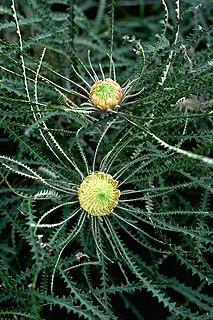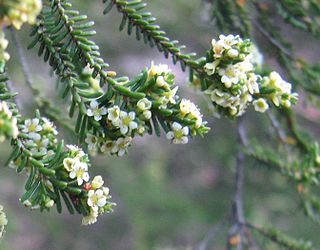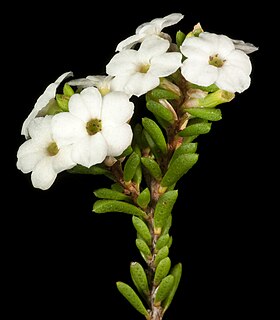
Banksia mucronulata, commonly known as swordfish dryandra, is a species of shrub that is endemic to Western Australia. It has spreading, hairy stems, linear, deeply pinnatifid leaves with sharply-pointed lobes, pale yellow to cream-coloured flowers in heads of between 80 and 180, and egg-shaped follicles.
John William Green is an Australian botanist.

Micromyrtus is a genus of shrubs, in the family Myrtaceae, described as a genus in 1865. The entire genus is endemic to Australia.

Alex George's taxonomic arrangement of Dryandra was the first modern-day arrangement of that taxon. First published in Nuytsia in 1996, it superseded the arrangement of George Bentham, which had stood for over a hundred years; it would later form the basis for George's 1999 treatment of Dryandra for the Flora of Australia. In accordance with contemporary thinking, George treated Dryandra as a genus, dividing it into three subgenera, the largest of which was divided into 24 series. The arrangement stood until 2007, when Dryandra was transferred into Banksia as B. ser. Dryandra. No alternative has yet been proposed.
Robert Brown's taxonomic arrangement of Dryandra was the first arrangement of what is now Banksia ser. Dryandra. His initial arrangement was published in 1810, and a further arrangement, including an infrageneric classification, followed in 1830. Aspects of Brown's arrangements can be recognised in the later arrangements of George Bentham and Alex George.

Grevillea mucronulata, also known as green spider flower or green grevillea, is a shrub of the family Proteaceae that is endemic to New South Wales in Australia. Described by Robert Brown in 1810, it is found in open sclerophyll forest or woodland around the Sydney region and New South Wales south coast. It grows as a small bush to 3 metres high and wide, with variable foliage and greenish flowers that appear over the cooler months from May to October. The flowers are attractive to birds.
Banksia mucronulata subsp. mucronulata is a subspecies of Banksia mucronulata (swordfish dryandra). As an autonym, it is defined as encompassing the type material of the species. It was known as Dryandra mucronulata subsp. mucronulata until 2007, when Austin Mast and Kevin Thiele transferred all Dryandra into Banksia. As with other members of Banksia ser. Dryandra, it is endemic to the South West Botanical Province of Western Australia.

Dryandra subg. Dryandra is an obsolete clade of plant. It was a series within the former genus Dryandra. The name was first published at sectional rank as Dryandra verae in 1830, before being renamed Eudryandra in 1847, the replaced by the autonym at subgenus rank in 1996. It was ultimately discarded in 2007 when Austin Mast and Kevin Thiele sunk Dryandra into Banksia.
Micromyrtus grandis, the Severn River heath-myrtle, is a shrub in the myrtle family. It is found exclusively in the Severn River Nature Preserve and a property next to it, located around 60 km north-west of Glen Innes (Australia). It grows up to 1–4 metres tall, making it the largest plant in the genus Micromyrtus. The Severn River heath-myrtle is characterized by its fruit, which is 5-ribbed, and its broader leaves when compared to other nearby flora.
Micromyrtus arenicola is a plant species of the family Myrtaceae endemic to Western Australia.
Micromyrtus barbata is a plant species of the family Myrtaceae endemic to Western Australia.

Micromyrtus elobata is a plant species of the family Myrtaceae endemic to Western Australia.
Micromyrtus fimbrisepala is a plant species of the family Myrtaceae endemic to Western Australia.
Micromyrtus hymenonema is a plant species of the family Myrtaceae endemic to Western Australia.
Micromyrtus obovata is a plant species of the family Myrtaceae endemic to Western Australia.
Micromyrtus rubicalyx is a plant species of the family Myrtaceae endemic to Western Australia.
Micromyrtus serrulata is a plant species of the family Myrtaceae endemic to Western Australia.
Micromyrtus stenocalyx is a plant species of the family Myrtaceae endemic to Western Australia.
Micromyrtus trudgenii is a plant species of the family Myrtaceae endemic to Western Australia.
Thryptomene mucronulata is a shrub species in the family Myrtaceae that is endemic to Western Australia.






